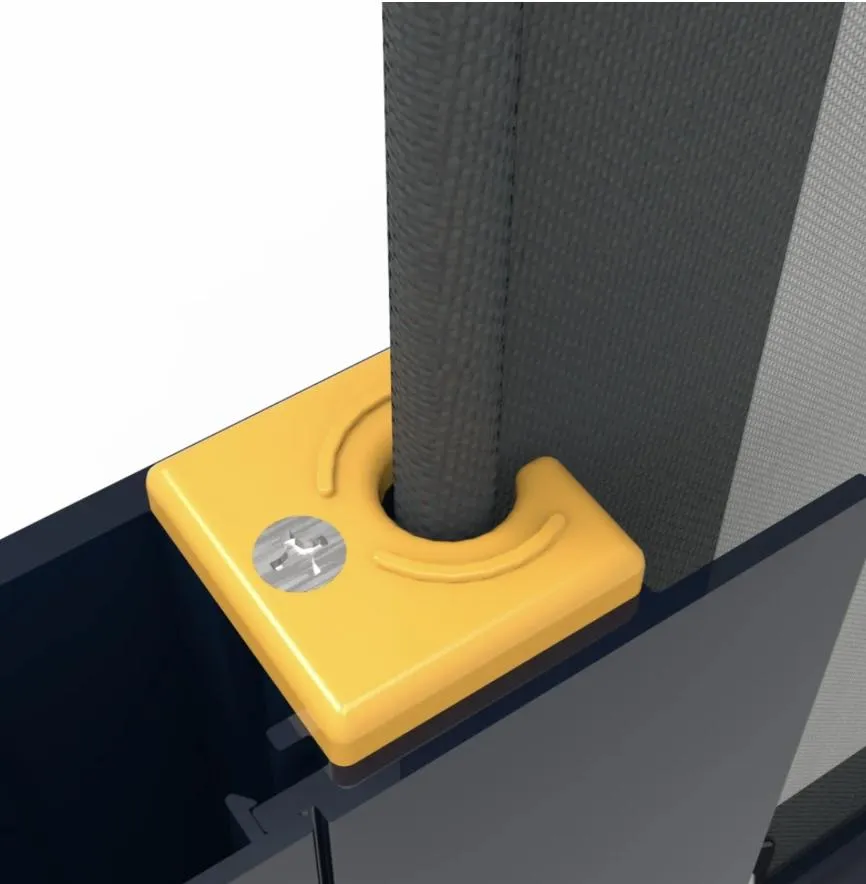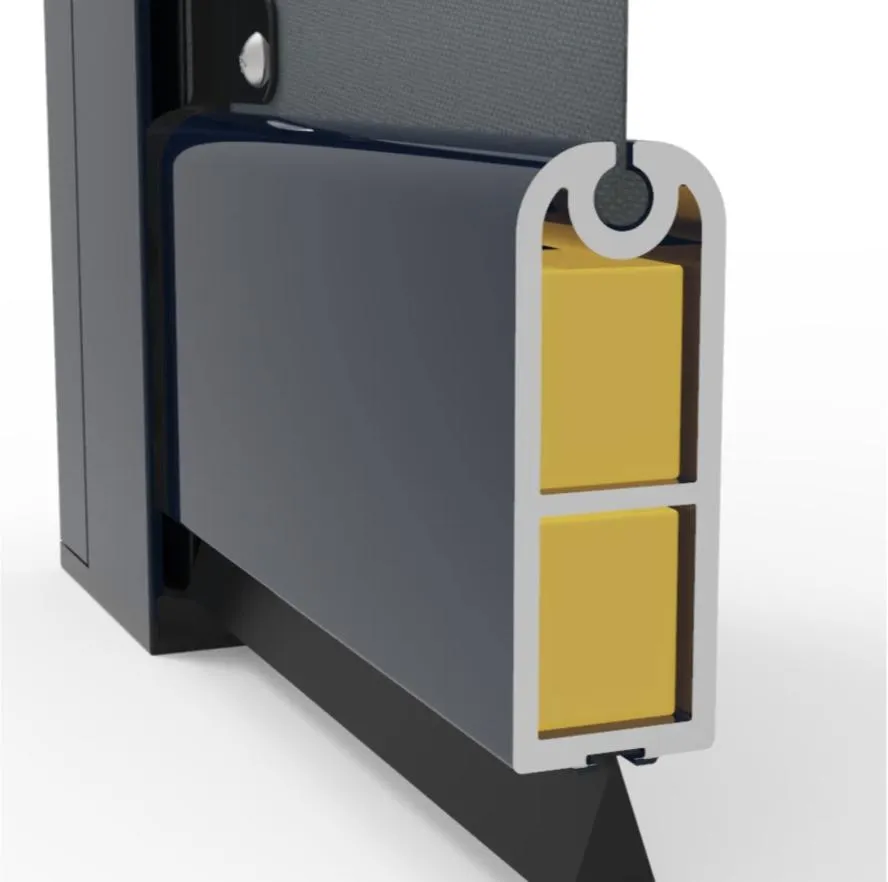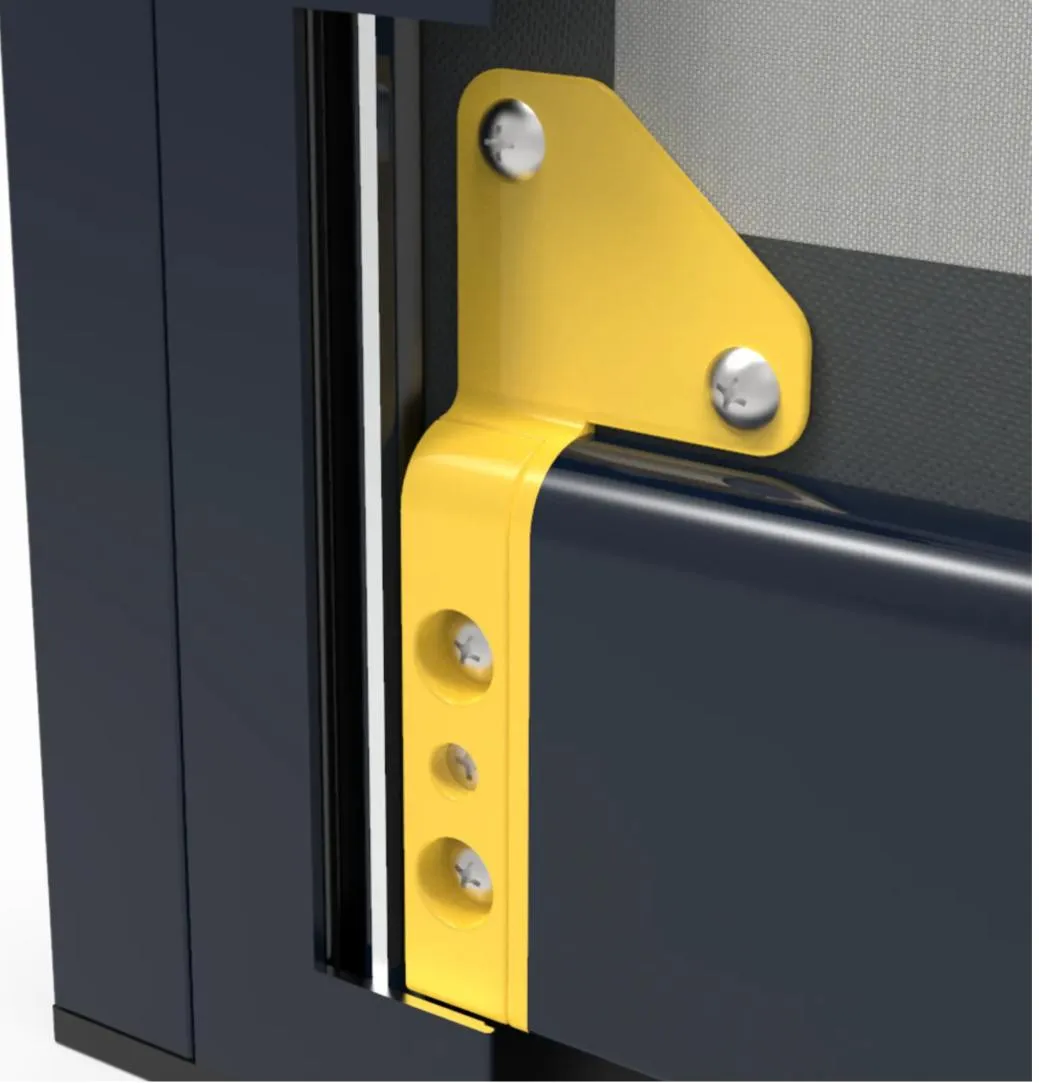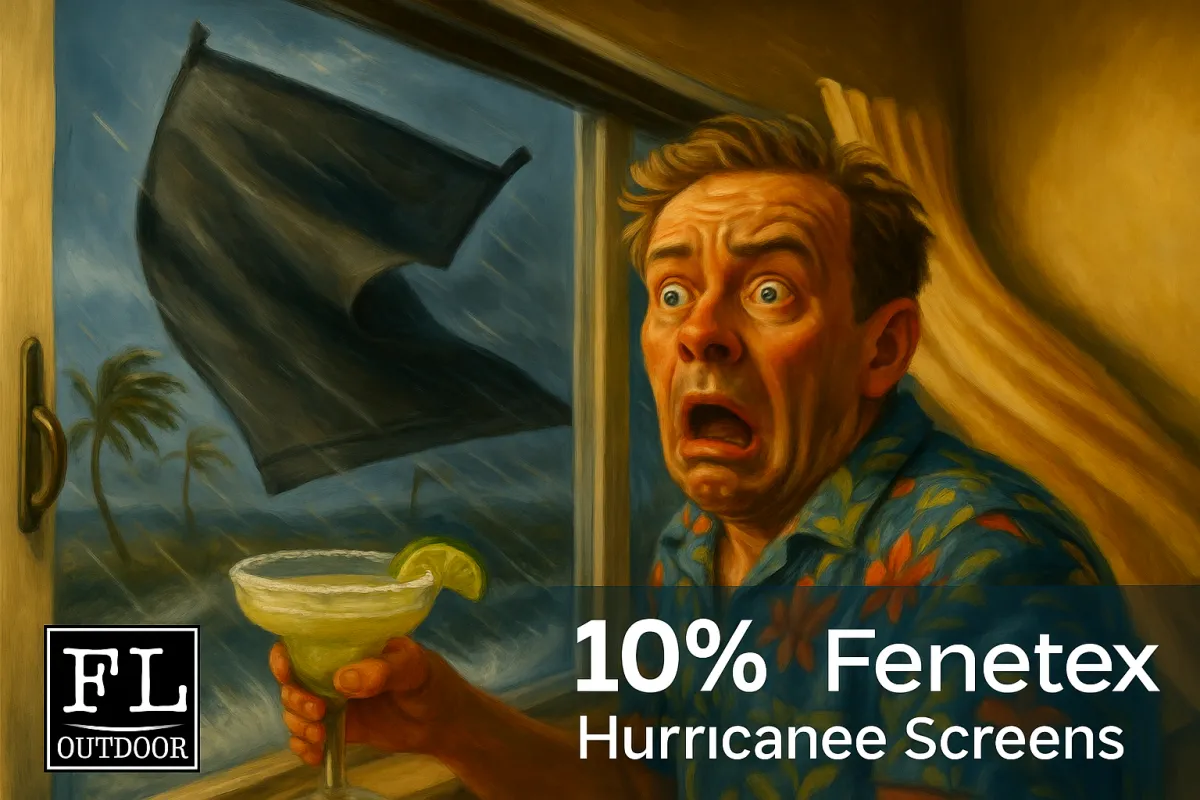ONE-TRACK MOTORIZED SCREEN
Why One-Track

ONE-TRACK MOTORIZED SCREEN
Why One-Track

MAXFORCE PROVEN PROTECT
Engineered For Excellence
For nearly two decades, Fenetex has manufactured hurricane screens to meet the most demanding building code, the High Velocity Hurricane Zone of Miami-Dade. The MaxForce track is our newest version of the fixed track we have used with great success for high wind applications all over the globe.
The benefits of a fixed track are unmatched strength - this is important when designing a screen system for hurricanes. When you want the strongest system available, and a proven veteran of many hurricanes, the Fenetex MaxForce Hurricane Track is your best choice.
MAXFORCE PROVEN PROTECT
Engineered For Excellence
For nearly two decades, Fenetex has manufactured hurricane screens to meet the most demanding building code, the High Velocity Hurricane Zone of Miami-Dade. The MaxForce track is our newest version of the fixed track we have used with great success for high wind applications all over the globe.
The benefits of a fixed track are unmatched strength - this is important when designing a screen system for hurricanes. When you want the strongest system available, and a proven veteran of many hurricanes, the Fenetex MaxForce Hurricane Track is your best choice.
FENETEX THE #1 MOTORIZED HURRICANE SCREEN
Contact A+ Certified One-Track Screen Dealer Today...
FENETEX THE #1 MOTORIZED
HURRICANE SCREEN
Contact A+ Certified
One-Track Screen
Dealer Today...
ONE-TRACK HURRICANE SCREENS
Engineering Features

No blowouts. No rewraps. No frustration.
One-Track is the only retractable screen system on the market designed to stay locked in the track—even in high winds. Smart motor senses resistance and adjusts seamlessly, allowing self-correction when the screen encounters an obstacle: Fewer snags, fewer jams, and fewer costly service calls.

No Zipper. No Cable. Just Simple Deployment
Fenetex pioneered Keder-edge technology in motorized screens, delivering unmatched durability and simplicity. Borrowed from sailboat rigging, this system eliminates zippers, cables, and exposed hardware—ensuring smooth, reliable operation every time.

Heavy Duty
The One-Track weight bar is engineered for strength—and built to hold its ground. Pound for pound, it’s the heaviest and most robust weight bar in the industry. This ensures proper screen tension, flawless deployment, and maximum stability in high wind zones. —limited flex, no failure.

Reinforced Corners
One-Track’s heavy-duty weight bar isn’t just strong. It’s smart. Reinforced corners and integrated tie-ins create a unified structure that acts like a solid wall of protection when deployed. Made from high-strength nylon, this bar absorbs impacts while maintaining structural integrity.
ONE-TRACK HURRICANE SCREENS
Engineering Features

No blowouts. No rewraps. No frustration.
One-Track is the only retractable screen system on the market designed to stay locked in the track—even in high winds. Smart motor senses resistance and adjusts seamlessly, allowing self-correction when the screen encounters an obstacle: Fewer snags, fewer jams, and fewer costly service calls.

No Zipper. No Cable. Just Simple Deployment
Fenetex pioneered Keder-edge technology in motorized screens, delivering unmatched durability and simplicity. Borrowed from sailboat rigging, this system eliminates zippers, cables, and exposed hardware—ensuring smooth, reliable operation every time.

Heavy Duty
The One-Track weight bar is engineered for strength—and built to hold its ground. Pound for pound, it’s the heaviest and most robust weight bar in the industry. This ensures proper screen tension, flawless deployment, and maximum stability in high wind zones. —limited flex, no failure.

Reinforced Corners
OneTrack’s heavy-duty weight bar isn’t just strong. It’s smart. Reinforced corners and integrated tie-ins create a unified structure that acts like a solid wall of protection when deployed. Made from high-strength nylon, this bar absorbs impacts while maintaining structural integrity.

HEADACHE-FREE
Exclusive self-tensioning system eliminates 99.9% of screen issues. No track adjustments, broken zippers,or dislodged screens.

WHISPER QUIET
Springs ensure even tension for peaceful patio relaxation without unwanted screen noise.

HURRICANE STRONG
Our MagForce tracks and advanced hybrid ballistic fabrics withstand 150+ mph winds. Approved by Florida Building Commission for hurricane zones. Lab and real-world tested.

BUILT TO LAST
We use marine-grade materials such as powder-coated aluminum, UV-protected nylons, stainless steel fasteners, and premium fabrics. Resists corrosion, rust, and screen failure.

COST-SAVING
Exterior shade screens reduce cooling bills and Fenetex hurricane screens reduce insurance premiums in hurricane zones.

SMART CONTROLS
Control Fenetex screens via remote and
phone or integrate with popular home automation systems for advanced
capabilities.

SECURE TRACK
MaxForce Fix Hurricane Track holds
firm under extreme loads

MAX CORROSION PROTECTION
Powder Coated Aluminum Protects your investment from exposer and corrosion.

HEAVY-DUTY DESIGN
Our screens are designed to withstand the extreme. High wind, Rain, or Shine, Dust Dirt, Dander, it doesn't matter. MaxForce Cover it all.

CUSTOM-MADE SCREENS
Tailor-made screens with vast color,
fabric, and system options. Custom paint color and fabric matching are available.

LIFETIME WARRANTY
No other company can stand behind their products like Fenetex can because no other company can match our quality.
FENETEX THE #1 MOTORIZED
HURRICANE SCREEN
Contact A+ Certified
One-Track Screen
Dealer Today...

HEADACHE-FREE
Exclusive self-tensioning system eliminates 99.9% of screen issues. No track adjustments, broken zippers,or dislodged screens.

WHISPER QUIET
Springs ensure even tension for peaceful
patio relaxation without unwanted
screen noise.

HURRICANE STRONG
Our MagForce tracks and advanced hybrid ballistic fabrics withstand 150+ mph winds. Approved by Florida Building Commission for hurricane zones. Lab and real-world tested.

BUILT TO LAST
We use marine-grade materials such as powder-coated aluminum, UV-protected nylons, stainless steel fasteners, and premium fabrics. Resists corrosion, rust, and screen failure.

COST-SAVING
Exterior shade screens reduce cooling bills and Fenetex hurricane screens reduce insurance premiums in hurricane zones.

SMART CONTROLS
Control Fenetex screens via remote and
phone or integrate with popular home automation systems for advanced
capabilities.

SECURE TRACK
MaxForce Fix Hurricane Track holds
firm under extreme loads

MAX CORROSION PROTECTION
Powder Coated Aluminum Protects your investment from exposer and corrosion.

HEAVY-DUTY DESIGN
Our screens are designed to withstand the extreme. High wind, Rain, or Shine, Dust Dirt, Dander, it doesn't matter. MaxForce Cover it all.

CUSTOM-MADE SCREENS
Tailor-made screens with vast color,
fabric, and system options. Custom paint color and fabric matching are available.

LIFETIME WARRANTY
No other company can stand behind their products like Fenetex can because no other company can match our quality.
FENETEX THE #1 MOTORIZED HURRICANE SCREEN
Contact A+ Certified One-Track Screen Dealer Today...
ONE-TRACK
Ready For Life's Storms

ONE-TRACK HURRICANE SCREEN SYSTEM
A Certified, Tested System...
The MaxForce Hurricane Screen System meets or exceeds Miami-Dade and Florida Building Code requirements—the toughest hurricane codes on earth—for roll-down hurricane screens. Rated for the 185 MPH wind zone, and with real-world and certified testing. With spans of up to 24 feet, they exceed performance criteria for all local and International Building Codes.
ONE-TRACK
Ready For Life's Storms

ONET-RACK HURRICANE SCREEN SYSTEM
A Certified, Tested System...
The MaxForce Hurricane Screen System meets or exceeds Miami-Dade and Florida Building Code requirements—the toughest hurricane codes on earth—for roll-down hurricane screens. Rated for the 185 MPH wind zone, and with real-world and certified testing. With spans of up to 24 feet, they exceed performance criteria for all local and International Building Codes.
FENETEX THE #1 MOTORIZED HURRICANE SCREEN
Contact A+ Certified One-Track Screen Dealer Today...
FENETEX THE #1 MOTORIZED
HURRICANE SCREEN
Contact A+ Certified
One-Track Screen
Dealer Today...
THE FENETEX DIFFERENCE
One-Track Hurricane Screen
MaxForce Hurricane Screens, powered by our patented MagForce system, meet the toughest standards—including HVHZ certification in Miami-Dade and Broward. They last longer, resist more, and do more than any screen on the market—proven protection without compromise.
MaxForce Hurricane Screens —Delivers 365 days of perfect protection, rain or shine, on your patio and lanai. With the push of a button or a tap on the mobile app, your patio is storm-ready— furniture and openings fully protected in seconds.
MaxForce Hurricane Screens fabric blocks up to 95% of the sun’s damaging UV-rays while shielding against wind, rain, insects, dust, and debris. It also helps reduce heat and lower energy costs by limiting solar exposure—comfort and protection in one smart solution.
Like all Fenetex products, our MaxForce Hurricane Screens are highly customizable and built to order—made to fit your exact openings. No guesswork, no compromises—just precision-fit protection tailored to your space.
Pair our retractable MaxForce Hurricane Screens with other Fenetex screens for customized and independent solutions. Each screen operates independently, giving you the protection you want when you need it.
MaxForce Hurricane Screens offer built-in privacy without blocking your view. Like a two-way mirror, you can see out—but neighbors and passersby can not see in. It provides the perfect blend of openness and seclusion, day or night.
THE FENETEX DIFFERENCE
One-Track Hurricane Screen
MaxForce Hurricane Screens, powered by our patented MagForce system, meet the toughest standards—including HVHZ certification in Miami-Dade and Broward. They last longer, resist more, and do more than any screen on the market—proven protection without compromise.
MaxForce Hurricane Screens —Delivers 365 days of perfect protection, rain or shine, on your patio and lanai. With the push of a button or a tap on the mobile app, your patio is storm-ready— furniture and openings fully protected in seconds.
MaxForce Hurricane Screens fabric blocks up to 95% of the sun’s damaging UV-rays while shielding against wind, rain, insects, dust, and debris. It also helps reduce heat and lower energy costs by limiting solar exposure—comfort and protection in one smart solution.
Like all Fenetex products, our MaxForce Hurricane Screens are highly customizable and built to order—made to fit your exact openings. No guesswork, no compromises—just precision-fit protection tailored to your space.
Pair our retractable MaxForce Hurricane Screens with other Fenetex screens for customized and independent solutions. Each screen operates independently, giving you the protection you want when you need it.
MaxForce Hurricane Screens offer built-in privacy without blocking your view. Like a two-way mirror, you can see out—but neighbors and passersby can not see in. It provides the perfect blend of openness and seclusion, day or night.
FENETEX THE #1 MOTORIZED HURRICANE SCREEN
Contact A+ Certified One-Track Screen Dealer Today...
FENETEX THE #1 MOTORIZED
HURRICANE SCREEN
Contact A+ Certified
One-Track Screen
Dealer Today...
THE FENETEX DIFFERENCE
One-Track Hurricane Screen
AMERICAN INGENUITY
Made in the USA.
Proudly Made in the USA—every Fenetex screen is built with American strength, precision, and pride. From the smallest components to the final assembly, our materials are sourced and manufactured right here in the United States. No outsourcing. No compromises. Just hardworking Americans protecting American homes with the toughest screen system on the market.
THE FENETEX DIFFERENCE
One-Track Hurricane Screen
AMERICAN INGENUITY
Made in the USA.

Proudly Made in the USA—every Fenetex screen is built with American strength, precision, and pride. From the smallest components to the final assembly, our materials are sourced and manufactured right here in the United States. No outsourcing. No compromises. Just hardworking Americans protecting American homes with the toughest screen system on the market.

When Jimmy Buffett Meets a Category 5: The Hilarious (and Costly) Truth About Hurricane Screens Without Footers
🍹When That Hurricane Screen Goes Flying Like a Pirate...
Say it aint so Jimmy: Hurricane Screen need Footers
Now listen up, my flip-flop-wearing, frozen-drink-sippin’ friends of Latitude Margaritaville, Daytona — we need to have a chat. Not about cheeseburgers. Not about boats. Nope... we're talkin’ about that fancy motorized hurricane screen you had slapped on your lanai. The one you bragged about at the Tiki Tuesday social hour.
Because here’s the deal: If the hurricane screen is over 22 feet, and that screen was installed without a concrete footer, you might as well kiss it goodbye when the wind kicks up. I’ve seen beer coasters with better anchoring.
🏖️ "It’s 5 O’Clock Somewhere" — But That Footer Ain’t Showin’ Up
You might’ve been told by your installer or local screen neigbor screen guy, in that smooth-talking, sunburnt way:
“Naw, you don’t need all that. It is overkill. We do this all the time!”
Well guess what? So do insurance adjusters — and they don’t pay out when your screen blows off like a beach umbrella in a squall. If that bad boy is longer than 22 feet and ain’t bolted into a concrete footer, the Florida Building Code says you’re not compliant, and that wind-rated masterpiece becomes a flying fish in the breeze.
We're talking IBC §1604.8, Florida Product Approvals, NOAs, and all the other boring-but-very-important codes. The fine folks at Fenetex, Alutech, and yes, even MagnaTrack, all say the same thing: bolt that sucker into concrete, or don't come crying when it ends up in a palm tree.
🌪️ "Blew Out My Flip-Flop, Stepped on a Screen Bar..."
Imagine this: You’re standing inside your paradise pad, sipping a sweet boat drink, watching the rain fall sideways. Then BAM! Your screen rips off like a toupee in a convertible. You scream. Your cat screams. Your margarita hits the floor.
And while the neighbors are still playing Jimmy’s greatest hits, your insurance company is playing a different tune:
“Claim denied. Improper installation.”
You’re left with a busted lanai, a soaked rug, and a suspicious HOA wondering how your screen ended up in Cheryl’s koi pond.
🧉 Don’t Let a Salesman Talk You Out of Common Sense
Look, we all love a good deal. But if someone told you “You don’t need a footer,” just to save a few coconuts, they weren’t doing you a favor. They were setting you up for a Category 5 letdown. And trust me — no one wants to be that guy in the Facebook group chat whose hurricane screen went rogue.
🏝️ What You Should Do (Preferably Before the Next Storm)
Call your installer and ask, “Did you put in a concrete footer? Can I see the permit and anchor schedule?”
If your screen spans over 22 feet, and they say “Nah, you’re good,” you’re probably not good.
Check your paperwork. If it doesn’t say “footer” or “engineered anchoring,” you might’ve bought a sail, not a screen.
Talk to your insurance agent now — not after the storm — and ask what’s covered if your screen fails.
🎶 Let’s Wrap It Up Like a Beach Towel
Here’s the bottom line: We love the laid-back lifestyle. But when it comes to protecting your slice of paradise, don’t let sunshine and salt air cloud your judgment. Whether you're in a Conch Cottage or a beachy bungalow in Latitude Margaritaville, your hurricane screen needs to be more than just pretty — it needs to be properly anchored.
So before the next storm rolls in off the Atlantic, do yourself a favor:
Ask the hard question... Where’s my footer?
If you don’t get a straight answer, grab your flip-flops, your cell phone, and call someone who knows what they’re doing.
And if that someone’s Florida Living Outdoor? Well then, you just might weather the next storm with your screen still standing... and your margarita still in hand.

When Jimmy Buffett Meets a Category 5: The Hilarious (and Costly) Truth About Hurricane Screens Without Footers
🍹When That Hurricane Screen Goes Flying Like a Pirate...
Say it aint so Jimmy: Hurricane Screen need Footers
Now listen up, my flip-flop-wearing, frozen-drink-sippin’ friends of Latitude Margaritaville, Daytona — we need to have a chat. Not about cheeseburgers. Not about boats. Nope... we're talkin’ about that fancy motorized hurricane screen you had slapped on your lanai. The one you bragged about at the Tiki Tuesday social hour.
Because here’s the deal: If the hurricane screen is over 22 feet, and that screen was installed without a concrete footer, you might as well kiss it goodbye when the wind kicks up. I’ve seen beer coasters with better anchoring.
🏖️ "It’s 5 O’Clock Somewhere" — But That Footer Ain’t Showin’ Up
You might’ve been told by your installer or local screen neigbor screen guy, in that smooth-talking, sunburnt way:
“Naw, you don’t need all that. It is overkill. We do this all the time!”
Well guess what? So do insurance adjusters — and they don’t pay out when your screen blows off like a beach umbrella in a squall. If that bad boy is longer than 22 feet and ain’t bolted into a concrete footer, the Florida Building Code says you’re not compliant, and that wind-rated masterpiece becomes a flying fish in the breeze.
We're talking IBC §1604.8, Florida Product Approvals, NOAs, and all the other boring-but-very-important codes. The fine folks at Fenetex, Alutech, and yes, even MagnaTrack, all say the same thing: bolt that sucker into concrete, or don't come crying when it ends up in a palm tree.
🌪️ "Blew Out My Flip-Flop, Stepped on a Screen Bar..."
Imagine this: You’re standing inside your paradise pad, sipping a sweet boat drink, watching the rain fall sideways. Then BAM! Your screen rips off like a toupee in a convertible. You scream. Your cat screams. Your margarita hits the floor.
And while the neighbors are still playing Jimmy’s greatest hits, your insurance company is playing a different tune:
“Claim denied. Improper installation.”
You’re left with a busted lanai, a soaked rug, and a suspicious HOA wondering how your screen ended up in Cheryl’s koi pond.
🧉 Don’t Let a Salesman Talk You Out of Common Sense
Look, we all love a good deal. But if someone told you “You don’t need a footer,” just to save a few coconuts, they weren’t doing you a favor. They were setting you up for a Category 5 letdown. And trust me — no one wants to be that guy in the Facebook group chat whose hurricane screen went rogue.
🏝️ What You Should Do (Preferably Before the Next Storm)
Call your installer and ask, “Did you put in a concrete footer? Can I see the permit and anchor schedule?”
If your screen spans over 22 feet, and they say “Nah, you’re good,” you’re probably not good.
Check your paperwork. If it doesn’t say “footer” or “engineered anchoring,” you might’ve bought a sail, not a screen.
Talk to your insurance agent now — not after the storm — and ask what’s covered if your screen fails.
🎶 Let’s Wrap It Up Like a Beach Towel
Here’s the bottom line: We love the laid-back lifestyle. But when it comes to protecting your slice of paradise, don’t let sunshine and salt air cloud your judgment. Whether you're in a Conch Cottage or a beachy bungalow in Latitude Margaritaville, your hurricane screen needs to be more than just pretty — it needs to be properly anchored.
So before the next storm rolls in off the Atlantic, do yourself a favor:
Ask the hard question... Where’s my footer?
If you don’t get a straight answer, grab your flip-flops, your cell phone, and call someone who knows what they’re doing.
And if that someone’s Florida Living Outdoor? Well then, you just might weather the next storm with your screen still standing... and your margarita still in hand.
Products
Resources
For Professionals
Connect

© 2025 One Track - Powered by Fenetex and Friends of Oatis | Privacy Policy | Terms of Service
Products
Resources
For Professionals
Connect

© 2025 One-Track - Powered by Fenetex and Friends of Oatis | Privacy Policy | Terms of Service

